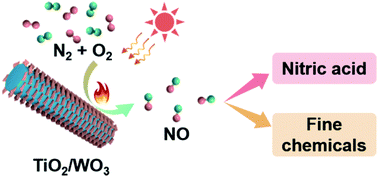A nitrogen fixation strategy to synthesize NO via the thermally assisted photocatalytic conversion of air†
Abstract
Developing a novel strategy for energy-efficient and clean synthesis of NO from distributed sources is highly desirable. Herein, we present a facile and green method to synthesize NO through the thermal-assisted photocatalytic oxidation of N2 using simulated air as the reactant in a flow reactor. The TiO2/WO3 heterostructured nanorods were constructed and exhibited good activity for NO photosynthesis assisted by heating in the range of 200–350 °C. The yield rate of NO reached 0.16 mmol g−1 h−1 at 300 °C with a quantum efficiency of 0.31% at 365 nm. 15N isotope labeling experiments proved the origin of NO from N2 oxidation. Experimental and theoretical results revealed that the lattice oxygen in the heterostructures participated in the photooxidation reaction of N2, and the electron transfer from WO3 to TiO2 at the interface of the heterojunction under illumination could facilitate the adsorption of N2 and the formation of NO* intermediates and thus enhanced the photocatalytic N2 oxidation performance. Importantly, the solar-driven oxidation generated NO can be directly used for the synthesis of fine chemicals including nitric acid and β-nitrostyrolene. Our work opens a new avenue for nitrogen fixation via solar-driven N2 oxidation from distributed sources of air.



 Please wait while we load your content...
Please wait while we load your content...